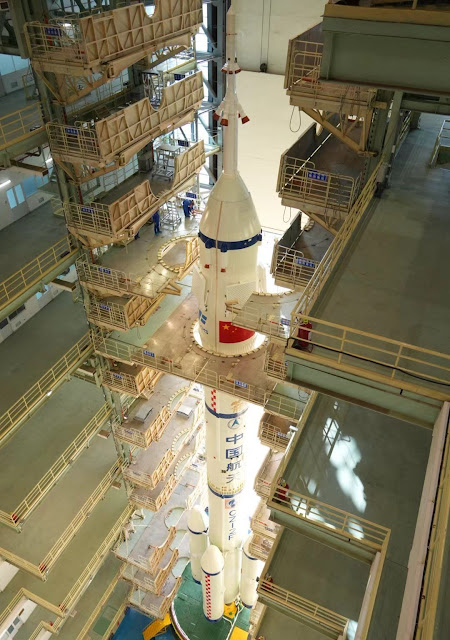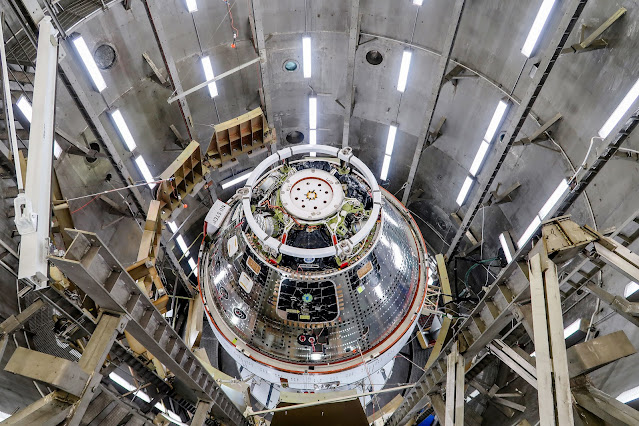NASA Apollo 9 Test Mission 1969: Scott & Schweickart on Spacewalk above Earth
Excellent view of the docked Apollo 9 Command and Service Modules (CSM) and Lunar Module (LM), with Earth in the background, during astronaut David R. Scott's stand-up extravehicular activity (EVA), on the fourth day of the Apollo 9 Earth-orbital mission. Scott, command module pilot, is standing in the open hatch of the Command Module (CM). Astronaut Russell L. Schweickart, lunar module pilot, took this photograph of Scott from the porch of the LM. Inside the LM was astronaut James A. McDivitt, Apollo 9 commander.
Image Date: March 3, 1969
Astronaut Russell L. Schweickart, lunar module pilot, is photographed from the Command Module (CM) "Gumdrop" during his extravehicular activity (EVA) on the fourth day of the Apollo 9 Earth-orbital mission. He holds, in his right hand, a thermal sample which he is retrieving from the Lunar Module (LM) exterior. The Command and Service Modules (CSM) and LM "Spider" are docked. Schweickart, wearing an Extravehicular Mobility Unit (EMU), is standing in "golden slippers" (foot restraints) on the LM porch. Visible on his back are the Portable Life Support System (PLSS) and Oxygen Purge System (OPS). Astronaut James A. McDivitt, Apollo 9 commander, was inside the LM. Astronaut David R. Scott, command module pilot, remained at the controls in the CM.
Image Date: March 6, 1969
Astronaut Russell L. Schweickart, lunar module pilot, operates a 70mm Hasselblad camera during his extravehicular activity (EVA) on the fourth day of the Apollo 9 Earth-orbital mission. The Command and Service Modules (CSM) and Lunar Module (LM) "Spider" are docked. This view was taken from the Command Module (CM) "Gumdrop". Schweickart, wearing an Extravehicular Mobility Unit (EMU), is standing in "golden slippers" on the LM porch. On his back, partially visible, are a Portable Life Support System (PLSS) and an Oxygen Purge System (OPS). Astronaut James A. McDivitt, Apollo 9 commander, was inside the "Spider". Astronaut David R. Scott, command module pilot, remained at the controls in the CM.
Image Date: March 6, 1969


A View of the Apollo 9 Lunar Module (LM), "Spider," in a lunar lading configuration, as photographed from the Command and Service Modules (CSM) on the fifth day of the Apollo 9 Earth-orbital mission. The landing gear on the "Spider" has been deployed. Inside the "Spider" were astronauts James A. McDivitt, Apollo 9 commander; and Russell L. Schweickart, lunar module pilot. Astronaut David R. Scott, command module pilot, remained at the controls in the Command Module (CM), "Gumdrop," while the other two astronauts checked out the LM.
Image Date: March 7, 1969

Fabulous view of the Apollo 9 Lunar Module, "Spider," in a lunar landing configuration, as photographed from the Command and Service Modules on the fifth day of the Apollo 9 Earth-orbital mission. The landing gear on the "Spider" has been deployed. Lunar surface probes (sensors) extend out from the landing gear foot pads. Inside the "Spider" were astronauts James A. McDivitt, Apollo 9 commander; and Russell L. Schweickart, lunar module pilot. Astronaut David R. Scott, command module pilot, remained at the controls in the Command Module, "Gumdrop," while the other two astronauts checked out the Lunar Module.
Image Date: March 7, 1969
A view of the Apollo 9 Lunar Module (LM), "Spider", in a lunar landing configuration, as photographed from the Command and Service Modules (CSM) on the fifth day of the Apollo 9 Earth-orbital mission. The landing gear on the "Spider" has been deployed. Lunar surface probes (sensors) extend out from landing gear foot pads. Inside the "Spider" were astronauts James A. McDivitt, Apollo 9 commander, and Russell L. Schweickart, lunar module pilot. Astronaut David R. Scott, command module pilot, remained at the controls in the Command Module (CM), "Gumdrop", while the other two astronauts checked out the Lunar Module.
Image Date: March 7, 1969
NASA Apollo 9 Official Mission Patch (1969)
The primary objective of Apollo 9 during its flight March 3-13, 1969 was an Earth-orbital engineering test of the first crewed lunar module, or LM. Other prime objectives included an overall checkout of launch vehicle and spacecraft systems, the crew, and procedures. This was done by performing an integrated series of flight tasks with the command module, or CM, the service module, or SM, the joined command and service module, or CSM, the LM and S-IVB stage while they were linked in launch or various docked configurations, and while they were flying independently. The LM was to be tested as a self-sufficient spacecraft, and was also to perform active rendezvous and docking maneuvers paralleling those scheduled for the following Apollo 10 lunar-orbit mission.
Apollo 9 Crew
Commander James McDivitt
Command Module Pilot David Scott
Lunar Module Pilot Russell Schweickart
The flight plan’s top priority was the CSM and LM rendezvous and docking. This was performed twice—once while the LM was still attached to the S-IVB, and again when the LM was active. Further goals included internal crew transfer from the docked CSM to the LM; special tests of the LM’s support systems; crew procedures; and tests of flight equipment and the extravehicular activity, or EVA, mobility unit. The crew also configured the LM to support a two-hour EVA, and simulated an LM crew rescue, which was the only planned EVA from the LM before an actual lunar landing.
The LM descent and ascent engines fired on orbital change patterns to simulate a lunar-orbit rendezvous and backup abort procedures. The CSM service propulsion system, or SPS, fired five times, including a simulation of an active rendezvous to rescue an LM that had become inactivate.
All prime mission objectives were met. All major spacecraft systems were successfully demonstrated. The few off-nominal conditions that developed did not affect achievement of the major goals.
Image Credit: NASA's Johnson Space Center (JSC)
Image Dates: March 3-7, 1969
#NASA #Space #Astronomy #Science #Planet #Earth #Moon #ApolloProgram #Apollo9 #ServiceModule #LunarModule #SpaceflightTest #EarthOrbit #Astronauts #JamesMcDivitt #DavidScott #RussellSchweickart #EVA #SpaceExploration #History #STEM #Education
.jpg)


























